The land of the ancient and extremely antique architecture of temples, Khajuraho is one of the prominent tourist destination of India and of the world for the all the architecture lovers. The land that is known for its temples holds a great historic significance. With the city called Orchha, famous for its forts and temples, both of them reflects the past in a unique way. Being the most important tourist destination of the state of Madhya Pradesh and the country. Depicting some of the fine architectural and art, these ancient temples fascinates the travelers especially the art and architectural enthusiasts within no time.
While Khajuraho is known for its erotic wall carvings, one can see the depiction of nymphs and men with their horses and orgies. The architectural carvings on temples is something that would leave one totally spellbind and awestruck. As the temples reflect magnificent views, almost all sites of Khajuraho are regarded as the UNESCO World Heritage Sites.
While as Khajuraho is known only for its temples and sculptures, Khajuraho Temples are also referred to as the Kamasutra Temples. It is believed that the architectures of the temples showcase their relation with the famous book of Vatsyayana’s. Yet the fact remains that they neither had any connection nor they were inspired by the book and so the percentage of the erotic or sexual art is just 10 percent.
With different temples, there are different believes that are maintained by the people of the town. Some natives and legends of the city are proud enough to state that the sculptures and the art carvings are the tantric sexual practices and some other legends quotes them for being a part of the Hindu Tradition and they freely accept sex or Kama as a crucial part of the everyday lives of human. Hence a city that is reflects the open mildness of the people that date back in the 10th century.
The land of alluring antiquities, Khajuraho is magnificent town of the state of Madhya Pradesh reflects the grand historic significance that is showcases in the world famous Temples of the city. The architectural monument that presents the various historic periods houses some of the famous UNESCO World Heritage Sites. The ornate temples are considered to be the dazzling masterpieces that were in the human imagination, artistic creativity, the alluring work of architectures and of course the spirituality that gave the message of peace through eroticism.
While these temples are the masterpieces very well known in the nation, these architectural marvels were built between the AD 900 and 1130 by the Chandella Rulers. As this time tenure came out to be the golden time period of the Chandella rulers, it is said that every Chandella ruler has built at least one temple in their lifetime. Thus this portrays the fact that these magnificent temples are not built by one very ruler. Hence the Temple Building was the known tradition of the rulers of the Chandella Dynasty.
Initially, there were 85 temples that were built on the land of Khajuraho and now, out of those 85 only 25 stands post a lot of preservation, maintenance and care. These architectural marvels of Khajuraho are spread across the area of 9 acres. It is believed that the history that was inked for Khajuraho has its first record of the building of the temple in the account of the Abu Rihan Biruni in 1022 AD and the well known Arab traveler, Ibn Battuta in 1335 AD.
Being the religious capital of Chandella Dynasty, it is believed that Chandella Rulers believed in the presence of religion and culture rather than politics and eventually with the making of these temples, the rulers tried to showcase their belief and thus discriminated the political activities over the religious and cultural activities. Making Khajuraho as their religious and cultural Capital, their political capital was established in Mahoba which lied at a distance of just 60 kilometer from Khajuraho. They constructed large walls around their religious capital that has eight gates. These eight gates were used for entry and exit only. While these gates were flanked by the two date’s trees, Khajuraho got its names as the Khajura - vahika.
As the Chandella Dynasty saw its fall post the 1150 AD, the area was invaded by the Muslim Rulers and their invasion resulted in the destruction, dismaintanance and disbursement of the temples. As the people were forced out of Khajuraho, Muslim rulers did not tolerate any kind of worshiping as they had their ruling policy of ‘intolerance for worship places of other religions’. People left Khajuraho in the belief that with their leaving the city, Muslim Rulers would not bear their attention to their crucial temples and so the temples would remain in safe condition.
As the area was left as it is, the city of Khajuraho and the temples were covered by the forest and they remained covered until the British Engineer T. S. Burt re discovered them.

Khajuraho has its own Airport; it’s situated at a mere distance of 4 Kilometers from the Rail mode of transportation [Khajuraho Railway station. This airport connects a few of the prominent touristic destinations of India – like Delhi, Allahabad, Varanasi etc. Here are the names of the Airlines, which provide their services – Jet Airways and Air India.

If road trip makes you feel awesome then you can travel a distance of nearly 655.20 kilometres via the Taj Express Highway [from Delhi to Khajuraho]. The closest city is Chhatarpur, which again is well-linked by road from Bhopal.

Khajuraho is equipped with a Railway station; this striking town, well-known for the Khajuraho group of Monuments is connected via train to Jhansi on the Delhi-Chennai line and Kanpur on the Howrah-Delhi line. It’s also linked by a daily train to Delhi via Mahoba, Gwalior and Jhansi. Here are the names of some more touristic spots of higher significance that are well-linked via trains from this town of artistry – Agra, Jaipur, Udaipur, Varanasi and Kanpur. A few other railheads situated close to Khajuraho are Mahoba, Katni, Jhansi, and Satna.
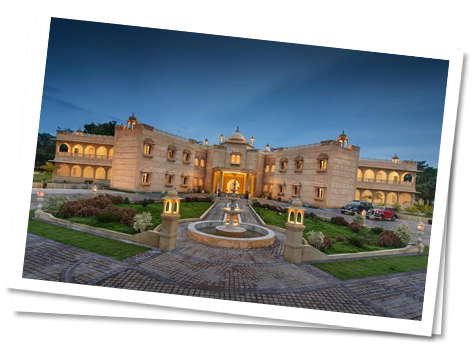
The small yet immensely influential town of Khajuraho is situated in the Bundelkhand region [Chhatarpur district] in the glorious state of Maharashtra. People belonging from the various walks of life and town visit this place of art and importance every year [some travel to Khajuraho on their own and some come along with a group of crazy friends etc]. All kind of hotels can be found in this prime town of Central India [from 2-star hotels to the 5- star]. Think of the level of comfort and choose your stay.
The artistic town of Khajuraho is settled in perfection; its home to an exceptional group of monuments, which are UNESCO World Heritage sites. A day is sufficient for one to explore the prominent tourist destinations of this enthralling town.
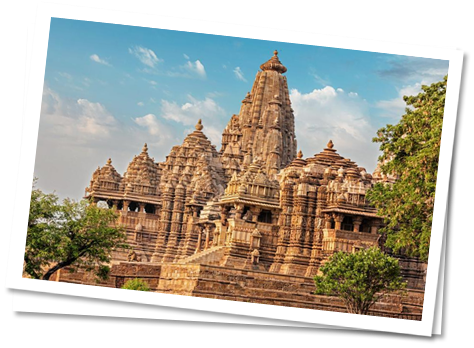
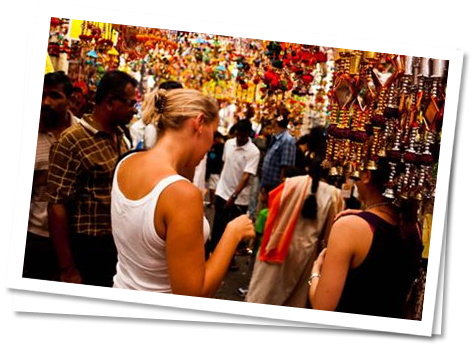
The mesmerizing town of Khajuraho is blessed with a great destiny, for the fact as it serves as home to the noteworthy group of Monuments. It not only lives in the pride of well-ornamented monuments [alluring sculptures etc] but it also resides as one of the well-famed touristic spots of Central India.
A trip remains incomplete without performing an activity of buying souvenirs; this town is well-equipped with several stores, which will serve your shopping time with various options. Here are the names of a few things to buy from Khajuraho [Khajuraho special]- Wooden statues, Metallic statues, precious stones, Handicraft items, antiques, home décor, printed ready-made clothes, Textile products, Silver goods, Sandstone miniature replicas, ethnic apparels etc.
Some prime shopping destinations in Khajuraho are –
1- The Gole market
2- Rajnagar Shopping zone
3- Shilpgram
The setting of Khajuraho is great in appearance as it houses the exceptional Khajuraho group of Monuments. The temples situated in the widespread complex portray the Nagara-style architectural symbolism and their erotic sculptures. This town of art and sculpture is truly amazing; the temples of Khajuraho are broadly segmented into three divisions: the Southern Group, the Eastern Group and the western group of temples of which the western group alone resides with the facility of an Audio guided tour.
Khajuraho dives deeper in the thickest layer of artistry especially in the month of February – the month of celebration [the Khajuraho Dance Festival. It charmingly features the various classical Indian dances set against the imposing backdrop of the Chitragupta or Vishwanath Temples. One can even spend quite some happening time enjoying the light and sound show, which is held every evening. Two shows are conducted – first show is in the English Language and the second is in Hindi. From the snacks to the meal menu – Khajuraho plays ahead when it comes to serving the best food; here are the names of some must-try dishes:
Mutton Kababs, Chicken Biryani, Moong Dal Halwa, Kusli, Cashew Barfi, Masala Kheema, Sabudana Khichdi etc. From the traditional to the continental food items – all are available in the restaurants of Khajuraho.
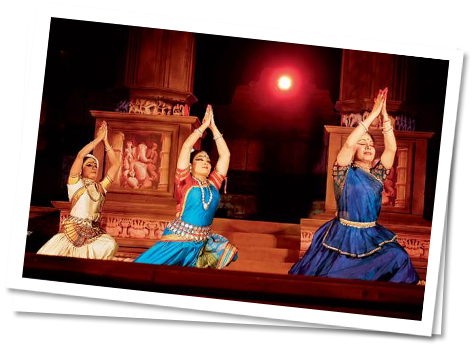
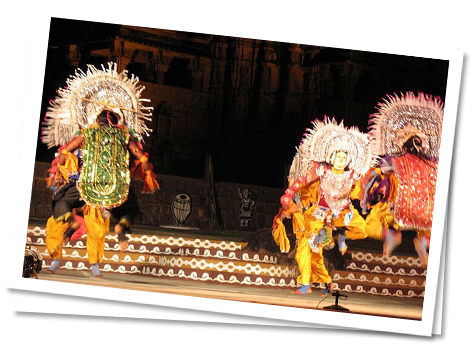
Most of the prime festivals of Hindus are gratefully celebrated in the town of Khajuraho; however which pulls most of the attention of every single traveller is the Khajuraho Dance Festival. This fascinating festival is organized by the Madhya Pradesh Kala Parishad; it’s a one-week festival of classical dances organized annually against the picture-perfect backdrop of the stunning Khajuraho Temples.
The festival is held in the month of February from 20th to the 26th. Various dance forms are a part of this phenomenal dance festival – Kathak, Odissi, Kuchipudi, Manipuri, Bharatnatyam and Kathakali [Modern Indian dance are a recent addition]. Numerous artists exhibit their skills and talent [performers travel all the way to this spot of celebration from various parts of the world]. Mahashivratri is also celebrated on a greater scale in this town.
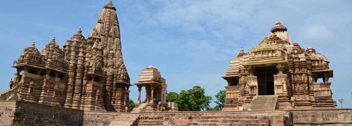
The most stunning and alluring temple of Khajuraho, Kandariya Mahadev Temple is famous for its beautiful architecture that includes the dazzling frescos of women in various postures adorning the walls of the temple. Being the finest example of the architectural style of that time period, it was built in the 1025 – 1050 AD.
Dedicated to Lord Shiva, this magnificent temple is an artistically engraved shrine that includes the 800+ images of women and amongst these images, most of them are of almost 3 feet high. Built with a typical sandstone structure, the walls of the temples are full of erotic carvings and a Shivlingam is acknowledged in the center of the Garba Griha.
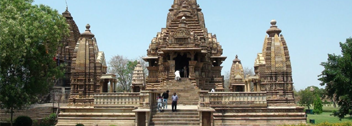
Considered to be in the Western group of the temples of Khajuraho, this beautiful shrine is dedicated to Lord Vishnu and is home to the beautiful image of the Vaikuntha-Vishnu. Considered to be the finest architecture, the exterior walls of the temples contains images of more than 600 Gods and the stubby platform of the temple called adhisthana creates the base on which the 25.9 meter long Lakshmana Temple stands.
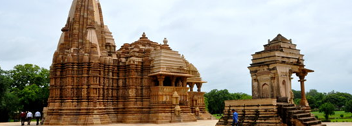
With extremely unique architecture stand the temples of the Devi Jagdamba which also regarded as the chef-d’oeuvre. Reflecting the erotic wall carvings on the topmost panel of structures, this shrine is not big in size yet it is considered to be the most magnificent temple because of its creative artistic architectural carvings that it houses.
Dedicated to the Goddess of Universe, the Goddess Jagdamba, this temple is a must-visit place for an art and architectural lover.
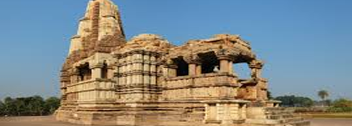
Located in the southern group of temples, Dulhadev or Dulhadeo Temple is dedicated to Lord Shiva and is located at the banks of the Kharau Nala. Built in the 1130, the temple is a example of the pure Chadella Architectural Style. The interiors of the temple house the images and carving of Lord Shiva and his wife, Goddess Parvati. The carvings on the walls contain the jeweler work and the perfect finishing of the other idols. With the decoration of the carvings with Apsaras and the other ornamented sculptures, this temple reflects the creativity and the artistic skills of the labourers.
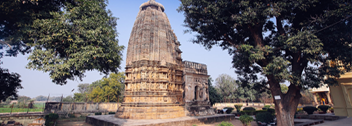
The temple that lies in the eastern group of temples of Khajuraho is a magnificent Jain Temple and is dedicated to the first Jain Tirthankar Adinath who was the founder of Jainism. With the alluring carvings of the Yakshis on the entire walls of the temples, it was built in the 11th century and houses the sura - sundari sculptures that are considered to be the biggest fascination of the travelers for this temple.
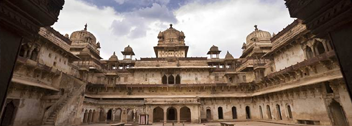
Located on Island of Betwa River, Orchha Fort is famous for its architecture and the temples and palaces that it houses. The three most crucial palaces that the fort house includes the Jahangir Mahal, Raj Mahal and the Rai Parveen Mahal. The fort is known for its mesmerizing views of the landscapes the palaces that attract visitors and especially the art and architecture lovers.
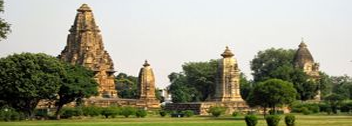
Constructed in the 17th century, the temple was founded by the Bundela Rajput Kings. The temple is famous for its architectural carvings and houses the spellbinding craftsmanship of the medieval times. Being a story temple, it is believed that the top views of the temple are stunning, making one completely awestruck and mesmerized.
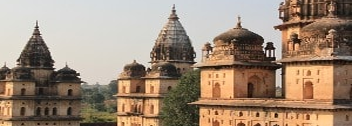
Built on the banks of the river Betwa, these 14 Chattris are the symbol of the contributions and inputs of every single ruler of the Bundela Dynasty. Being the symbol of the rich culture and heritage, it reflects the great grand glory and grandeur of the kings and the empire that once lived.
Copyright © 2020 Travelsite India All Right Reserved